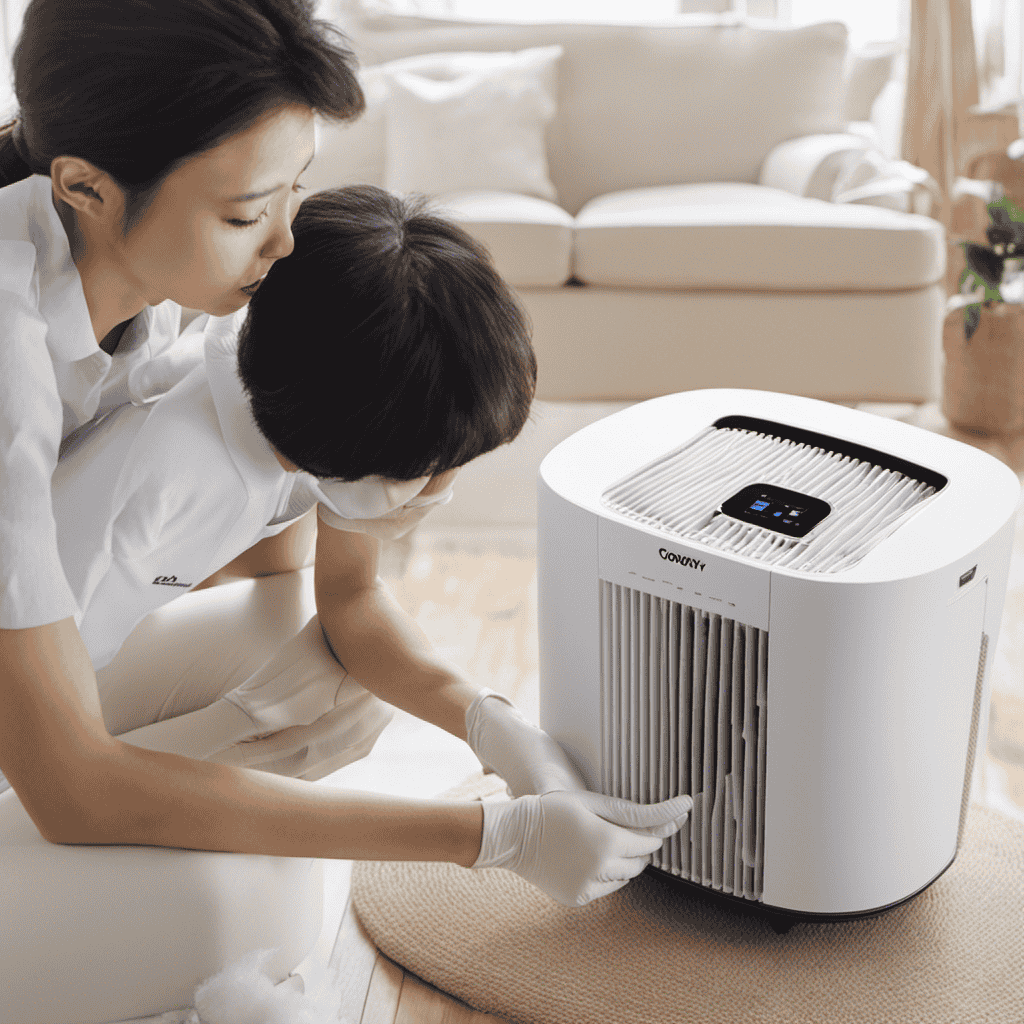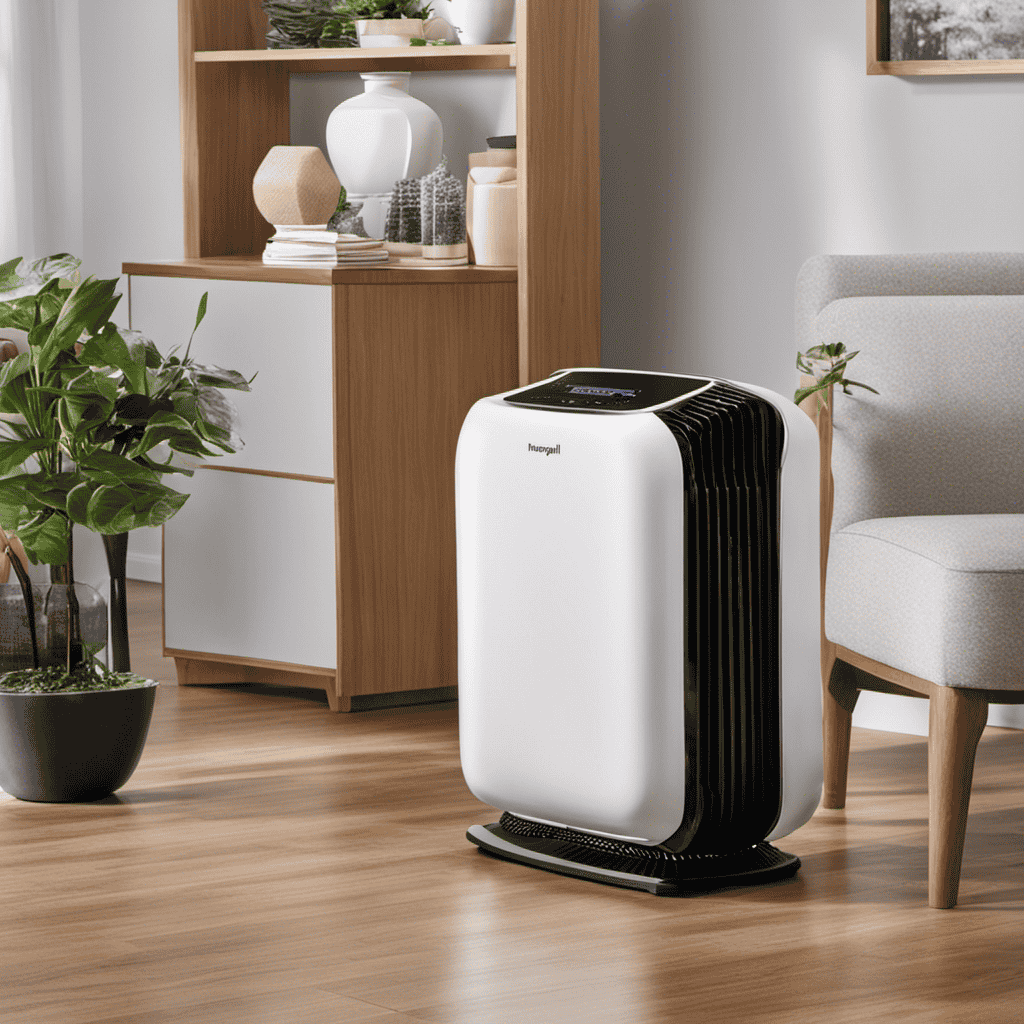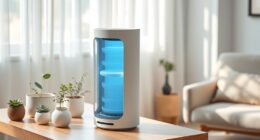As a Coway Air Purifier owner, I recognize the significance of routine cleaning to uphold peak performance. This detailed guide will lead you through the process of cleaning every component, including the pre-filter, carbon filter, and HEPA filter.
We will also discuss how often you should clean your air purifier and troubleshoot common cleaning issues.
So, let’s dive in and discover how to keep your Coway Air Purifier in tip-top shape for cleaner, fresher air in your home.
Key Takeaways
- Regular cleaning and maintenance of the Coway Air Purifier is important for maintaining its efficiency and prolonging its lifespan.
- The HEPA filter should be cleaned every 6 months, while the activated carbon filter should be replaced every 6 months.
- Cleaning the pre-filter every three months helps remove visible dirt and debris buildup.
- Regularly inspect and clean the fan blades, check for airflow obstructions, and inspect the motor for wear or damage.
Why Is It Important to Clean Your Coway Air Purifier Regularly
Why is it important for you to clean your Coway air purifier regularly?
Regular cleaning of your Coway air purifier offers numerous benefits and ensures its proper maintenance.
Firstly, regular cleaning helps to maintain the efficiency of the air purifier. Over time, the filters inside the purifier accumulate dust, allergens, and other pollutants, reducing their effectiveness. By cleaning the filters regularly, you ensure that the air purifier can continue to effectively remove these contaminants from the air.
Secondly, regular cleaning helps to prolong the lifespan of your air purifier. Dust buildup can strain the motor and other components, leading to premature wear and tear. By cleaning your air purifier regularly, you can prevent damage and extend its lifespan.
Lastly, regular cleaning ensures that the air you breathe is clean and healthy. By removing accumulated pollutants from the filters, you can maintain the purification efficiency and enjoy fresh, clean air in your space.
Understanding the Different Parts of Your Coway Air Purifier
When it comes to understanding my Coway Air Purifier, it’s important for me to know about its key components and the function of each part.
This knowledge allows me to effectively maintain and troubleshoot my purifier, ensuring it works optimally.
Key Purifier Components
The key purifier components include a HEPA filter and an activated carbon filter. The HEPA filter is designed to capture and remove small particles such as dust, pollen, and pet dander from the air. The activated carbon filter, on the other hand, is responsible for trapping odors and harmful gases.
To ensure that these components continue to work effectively, proper cleaning and maintenance techniques are essential. Here are some tips to keep your Coway air purifier in top shape:
-
Cleaning Techniques:
- Regularly vacuum the surface of the purifier to remove any dust or debris.
- Clean the HEPA filter every 6 months by gently vacuuming or rinsing it with water.
- Replace the activated carbon filter every 6 months or as needed.
-
Maintenance Tips:
- Check the filter indicator light regularly to know when it’s time for a replacement.
- Keep the air purifier away from direct sunlight and water sources.
- Follow the manufacturer’s instructions for proper usage and maintenance.
Function of Each Part
Regular maintenance is crucial to keep the key purifier components, such as the HEPA filter and activated carbon filter, working effectively. To ensure optimal performance of the Coway air purifier, it is important to use the right cleaning supplies and techniques. Here are some maintenance tips to help you keep your air purifier in top shape:
- Regularly clean the pre-filter to remove larger particles and extend the lifespan of the other filters.
- Use a soft brush or vacuum cleaner attachment to gently clean the surface of the HEPA filter.
- For the activated carbon filter, wipe it with a damp cloth to remove any dust or debris.
- Clean the outer surface of the air purifier using a mild detergent and a soft cloth.
By following these maintenance techniques and using the appropriate cleaning supplies, you can ensure that your Coway air purifier continues to provide you with clean and fresh air.
Now, let’s move on to the next section, where I will provide you with a step-by-step guide to cleaning the pre-filter.
Step-By-Step Guide to Cleaning the Pre-Filter
When it comes to maintaining the pre-filter in my Coway air purifier, there are a few key tips that I always keep in mind.
First, it’s important to regularly inspect the pre-filter for any visible dirt or debris buildup.
Secondly, I make sure to clean the pre-filter every three months to ensure optimal performance.
Lastly, I always follow the manufacturer’s recommendations for cleaning frequency to ensure that the pre-filter is effectively capturing pollutants and extending the lifespan of my air purifier.
Pre-Filter Maintenance Tips
For optimal performance, it’s important to regularly clean the pre-filter of your Coway air purifier. Here are some tips to help you maintain and clean your pre-filter effectively:
- Gently remove the pre-filter from the air purifier.
- Use a soft brush or vacuum cleaner with a brush attachment to remove dust and debris from the pre-filter.
- If the pre-filter is heavily soiled, you can rinse it under running water. Make sure to let it dry completely before reinstalling.
It’s recommended to clean the pre-filter every two weeks or as needed, depending on the air quality in your home.
Regular cleaning of the pre-filter will ensure that your Coway air purifier functions optimally and extends the lifespan of the filter. Remember, if cleaning is no longer effective, it’s time for a pre-filter replacement.
Cleaning Frequency Recommendations
To maintain optimal performance, you should aim to clean the pre-filter every two weeks or as needed, depending on the air quality in your home. Regular cleaning of the pre-filter is essential to ensure that your Coway air purifier is effectively removing pollutants from the air. Here are some cleaning techniques and best practices to keep in mind:
| Cleaning Technique | Best Practice |
|---|---|
| Vacuuming | Use a vacuum cleaner with a brush attachment to remove dust and debris from the pre-filter. |
| Washing | Gently wash the pre-filter with warm water and mild soap. Rinse thoroughly and let it air dry. |
| Replacement | If the pre-filter is damaged or heavily soiled, it may be necessary to replace it with a new one. |
How to Clean the Carbon Filter in Your Coway Air Purifier
To clean the carbon filter in your Coway air purifier, follow these simple steps:
-
Turn off the air purifier and unplug it from the power source.
-
Locate the carbon filter compartment, usually at the back or side of the purifier.
-
Open the compartment by removing the cover or sliding it out.
-
Carefully remove the carbon filter, which may be dirty and contain dust particles.
-
Use a vacuum cleaner or a soft brush to remove any visible dirt or debris from the filter.
-
If the filter is heavily soiled, rinse it with water and let it dry completely before reinstalling.
-
Put the cleaned or new carbon filter back into the compartment.
-
Close the cover and plug in the air purifier.
Remember to follow the manufacturer’s instructions and maintenance schedule for optimal performance.
Cleaning the HEPA Filter: a Detailed Tutorial
When it comes to maintaining the filters in your air purifier, there are a few key tips to keep in mind.
First and foremost, it’s important to regularly clean and replace the filters according to the manufacturer’s recommendations.
Additionally, be sure to check the filters for any signs of damage or clogging that may affect their effectiveness.
Filter Maintenance Tips
Regularly cleaning and replacing the filters is crucial for maintaining the performance of your Coway air purifier. As an owner of a Coway air purifier, I understand the importance of proper filter maintenance. Here are some tips to help you keep your air purifier in top shape:
-
Regularly clean the pre-filter: The pre-filter helps capture larger particles and prolongs the life of the main filter. Vacuum or rinse the pre-filter every two weeks to remove dust and debris.
-
Replace the pre-filter: Over time, the pre-filter may become worn out or damaged. Replace it every six months to ensure optimal performance.
-
Troubleshoot common issues: If your air purifier is not working properly, try resetting it by unplugging it for a few minutes and then plugging it back in. Also, make sure the filters are properly installed and that the air intake is not blocked.
-
Contact customer support: If you encounter any persistent issues or have questions about filter maintenance, don’t hesitate to reach out to Coway’s customer support for assistance.
Cleaning Frequency Recommendations
Now that we have discussed filter maintenance tips for your Coway air purifier, let’s move on to cleaning frequency recommendations.
Proper cleaning is essential to ensure that your air purifier continues to function effectively and efficiently.
The frequency of cleaning your air purifier will depend on several factors such as the environment it is used in and the amount of pollutants it is exposed to. As a general guideline, it is recommended to clean the exterior of your air purifier every week. This can be done easily using a soft, damp cloth to wipe away any dust or dirt.
In addition to regular exterior cleaning, it is important to deep clean your air purifier at least once every three months. This involves removing the filters and cleaning them according to the manufacturer’s instructions. Some filters may be washable, while others may require replacement.
Tips for Removing and Cleaning the Ionizer in Your Coway Air Purifier
To properly clean your Coway air purifier, it’s important to know how to remove and clean the ionizer. The ionizer helps to eliminate particles and odors from the air, so keeping it clean is crucial for optimal performance. Here are some cleaning methods and best practices to ensure effective maintenance:
-
Unplug the purifier: Before starting any cleaning process, make sure to unplug the unit to avoid any electrical mishaps.
-
Remove the ionizer: Locate the ionizer in your air purifier and carefully remove it according to the manufacturer’s instructions.
-
Gently clean the ionizer: Use a soft brush or cloth to gently wipe away any dust or debris from the ionizer. Avoid using water or harsh chemicals as they may damage the unit.
-
Reinstall the ionizer: Once the ionizer is clean, carefully place it back into the air purifier and secure it properly.
Following these cleaning methods and best practices will ensure that your Coway air purifier continues to provide you with clean and fresh air.
Maintaining the Air Quality Sensor in Your Coway Air Purifier
Make sure you regularly check and calibrate the air quality sensor in your Coway air purifier to ensure accurate readings. Proper maintenance of the air quality sensor is essential to ensure that your air purifier is effectively removing pollutants and providing you with clean and healthy air.
To clean the sensor, start by turning off the air purifier and unplugging it from the power source. Gently remove the sensor cover, being careful not to damage any components. Use a soft, dry cloth or a brush to remove any dust or debris from the sensor. Avoid using water or any liquid cleaners.
Once the sensor is clean, replace the cover and plug the air purifier back in. Regularly cleaning and calibrating the air quality sensor will help maintain the performance and accuracy of your Coway air purifier.
Cleaning the Fan and Motor of Your Coway Air Purifier
Regularly checking and maintaining the fan and motor of your Coway air purifier is important to keep it running efficiently and effectively. Neglecting these components can lead to poor air quality and reduced performance.
To ensure your air purifier stays in top condition, here are some essential maintenance tips:
- Clean the fan blades regularly to remove dust and debris buildup.
- Check for any obstructions that may be blocking the fan’s airflow.
- Inspect the motor for signs of wear or damage and replace if necessary.
- Lubricate the motor bearings periodically to prevent friction and overheating.
By following these maintenance practices, you can prolong the lifespan of your Coway air purifier and maintain optimal air purification.
Now, let’s move on to learning how to clean the air vents and grilles of your Coway air purifier.
How to Clean the Air Vents and Grilles of Your Coway Air Purifier
Checking and cleaning the air vents and grilles of your Coway air purifier helps maintain its performance and efficiency. These components play a crucial role in filtering and circulating clean air throughout your space.
To clean the air vents and grilles, start by unplugging the unit and removing the front cover. Use a soft brush or vacuum cleaner attachment to gently remove dust and debris from the vents and grilles. For stubborn dirt, you can use a damp cloth or sponge with mild detergent, ensuring it is not dripping wet.
Allow the components to dry completely before reassembling the unit. It is recommended to clean the air vents and grilles every two to three weeks as part of your regular maintenance schedule to ensure optimal performance and prolong the lifespan of your Coway air purifier.
Cleaning the Control Panel and Display of Your Coway Air Purifier
To ensure proper functionality, remember to periodically wipe down the control panel and display of your Coway air purifier. Cleaning the control panel and display is an important step in maintaining your air purifier’s performance and prolonging its lifespan. Here are some recommended cleaning techniques and tools:
- Use a soft, lint-free cloth to gently wipe the control panel and display.
- Avoid using abrasive cleaners or harsh chemicals as they may damage the surface.
- For stubborn stains or fingerprints, dampen the cloth with a mild soap and water solution.
- Make sure to dry the control panel and display thoroughly before turning on the air purifier.
By following these cleaning techniques and using the recommended tools, you can keep your Coway air purifier looking clean and functioning optimally.
Now, let’s move on to using the appropriate cleaning solutions for your Coway air purifier.
Using the Appropriate Cleaning Solutions for Your Coway Air Purifier
When it comes to cleaning my Coway Air Purifier, I always make sure to use safe cleaning solutions that won’t damage the device. It’s important to choose cleaning products that are recommended by the manufacturer to ensure the longevity and effectiveness of the purifier.
In this discussion, I will delve into the topic of safe cleaning solutions and recommended cleaning products for your Coway Air Purifier.
Safe Cleaning Solutions
Make sure you’re using safe cleaning solutions to clean your Coway air purifier. When it comes to maintaining the cleanliness of your air purifier, it’s important to use products that are not only effective but also safe for both you and the machine.
Here are some cleaning techniques and effective cleaning methods to keep in mind:
-
Use mild, non-toxic cleaning solutions: Opt for gentle, non-abrasive solutions that are specifically designed for air purifiers. Avoid harsh chemicals that may damage the machine or leave behind harmful residues.
-
Follow the manufacturer’s instructions: Read the user manual carefully to understand the recommended cleaning solutions and techniques for your specific Coway air purifier model.
-
Regularly clean the filters: Clean or replace the filters as instructed by the manufacturer to maintain optimal performance.
-
Use distilled or filtered water: When cleaning the water tank or humidifying function, use distilled or filtered water to prevent mineral buildup and ensure clean, fresh air.
Recommended Cleaning Products?
After learning about safe cleaning solutions for my Coway air purifier, I wanted to find out what cleaning products are recommended for effectively maintaining its performance. Through my research, I discovered several cleaning techniques and effective methods that can help me keep my air purifier in top condition.
One of the recommended cleaning products is a soft, lint-free cloth, which is used to wipe down the exterior of the purifier to remove any dust or dirt buildup. For cleaning the pre-filter and HEPA filter, it is suggested to use a vacuum cleaner with a brush attachment to gently remove any trapped particles.
In addition, using a mild detergent mixed with warm water can be effective in cleaning the washable filters. After rinsing the filters thoroughly, they should be air-dried completely before reinstalling.
How Often Should You Clean Your Coway Air Purifier
You should clean your Coway air purifier regularly to ensure optimal performance. Cleaning frequency may vary depending on factors such as air quality, usage, and the specific model of your air purifier. However, as a general guideline, it is recommended to clean your Coway air purifier every 2 to 4 weeks.
Here are some best cleaning practices to keep in mind:
- Vacuum the external surface of the air purifier to remove any dust or debris.
- Clean the pre-filter by gently washing it with water and mild detergent, then allowing it to dry completely.
- Replace the carbon filter every 6 to 12 months, or as recommended by the manufacturer.
- Clean the HEPA filter by gently brushing off any accumulated dust or debris, or follow the manufacturer’s instructions for cleaning or replacing.
Troubleshooting Common Cleaning Issues With Your Coway Air Purifier
If your Coway air purifier is experiencing common cleaning issues, troubleshooting can help resolve them.
One common issue is a dirty filter. If you notice a decrease in air quality or airflow, it may be time to clean or replace the filter. To clean the filter, gently vacuum it or rinse it under running water.
Another issue could be a clogged air intake. Check for any obstructions and remove them if necessary.
Additionally, if your air purifier is emitting an unpleasant odor, it may be due to a dirty pre-filter. Cleaning or replacing the pre-filter can help eliminate the odor.
Regular maintenance is key to keeping your Coway air purifier running smoothly. Remember to clean or replace the filters regularly and keep the air intake free from debris.
Safety Precautions to Keep in Mind While Cleaning Your Coway Air Purifier
Now that we’ve covered some troubleshooting tips for cleaning your Coway air purifier, let’s talk about the safety precautions you should keep in mind while cleaning it.
Cleaning your air purifier is essential for maintaining its efficiency and prolonging its lifespan, but it’s important to be aware of potential hazards. Here are some safety precautions to consider:
-
Turn off and unplug the air purifier: Before starting any cleaning process, make sure the unit is switched off and unplugged to avoid any electrical accidents.
-
Use gentle cleaning techniques: Avoid using harsh chemicals or abrasive materials that can damage the sensitive components of the air purifier.
-
Clean in a well-ventilated area: Ensure that you are cleaning the air purifier in a well-ventilated space to prevent inhaling any dust or particles that may be released during the cleaning process.
-
Follow the manufacturer’s instructions: Always refer to the user manual provided by Coway for specific cleaning instructions and guidelines.
By following these safety precautions, you can clean your Coway air purifier effectively while minimizing any potential risks.
Now, let’s move on to additional maintenance tips for maximizing the lifespan of your Coway air purifier.
Additional Maintenance Tips for Maximizing the Lifespan of Your Coway Air Purifier
When it comes to maintaining your Coway air purifier and extending its lifespan, there are some additional maintenance tips to keep in mind.
Maximizing performance and preventing malfunctions is essential for getting the most out of your air purifier. Firstly, make sure to regularly clean the pre-filter and replace it every three months to remove large particles and prolong the life of the main filter.
Additionally, clean the main filter every six months to remove any accumulated dust and maintain optimal air purification. Don’t forget to clean the sensor area using a soft brush to ensure accurate air quality readings.
Lastly, keep the air purifier in a well-ventilated area and avoid placing it near heat sources or direct sunlight to prevent overheating.
Frequently Asked Questions
Can I Use Any Cleaning Solution to Clean My Coway Air Purifier, or Are There Specific Ones Recommended?
I always make sure to use the recommended cleaning solution when cleaning my Coway air purifier. It’s important to follow the best practices for cleaning to ensure the longevity and efficiency of the purifier.
What Should I Do if My Coway Air Purifier Is Not Turning on After Cleaning?
If my Coway air purifier is not turning on after cleaning, I would try troubleshooting tips such as checking the power source, ensuring all parts are properly reassembled, and contacting customer support for further assistance with common issues.
How Often Should I Clean the Air Vents and Grilles of My Coway Air Purifier?
I clean the air vents and grilles of my Coway air purifier once a month. I use a mild cleaning solution and a soft cloth to gently wipe away any dust or debris.
Are There Any Safety Precautions I Should Keep in Mind While Cleaning My Coway Air Purifier?
When cleaning my Coway air purifier, I always remember to unplug it and avoid using harsh chemicals. It’s important to clean the filters regularly and gently wipe the exterior. Taking these safety precautions helps maintain its performance and longevity.
What Are Some Additional Maintenance Tips for Maximizing the Lifespan of My Coway Air Purifier?
To maximize the lifespan of my Coway air purifier, I follow additional maintenance tips. Regularly cleaning the filters and exterior, keeping it in a clean environment, and avoiding excessive use can help prolong its effectiveness and durability.
Can Following the Instructions for Using a Coway Air Purifier Help in Cleaning It as Well?
Yes, following the instructions for using Coway air purifier can help in cleaning it as well. Proper maintenance and cleaning as per the guidelines provided can ensure that the air purifier continues to function effectively and efficiently, providing clean and fresh air in your home or office.
Conclusion
In conclusion, cleaning your Coway air purifier regularly is essential to ensure its optimal performance and longevity. By following the step-by-step guide provided in this article, you can effectively clean the pre-filter, carbon filter, and HEPA filter.
Maintaining cleanliness in these filters will help remove pollutants and allergens from your indoor air, providing you with cleaner and healthier air to breathe. For example, Sarah, a frequent sufferer of allergies, noticed a significant improvement in her symptoms after regularly cleaning her Coway air purifier.
By incorporating these cleaning techniques into your routine, you can enjoy the benefits of a well-maintained air purifier and breathe easier in your home.










